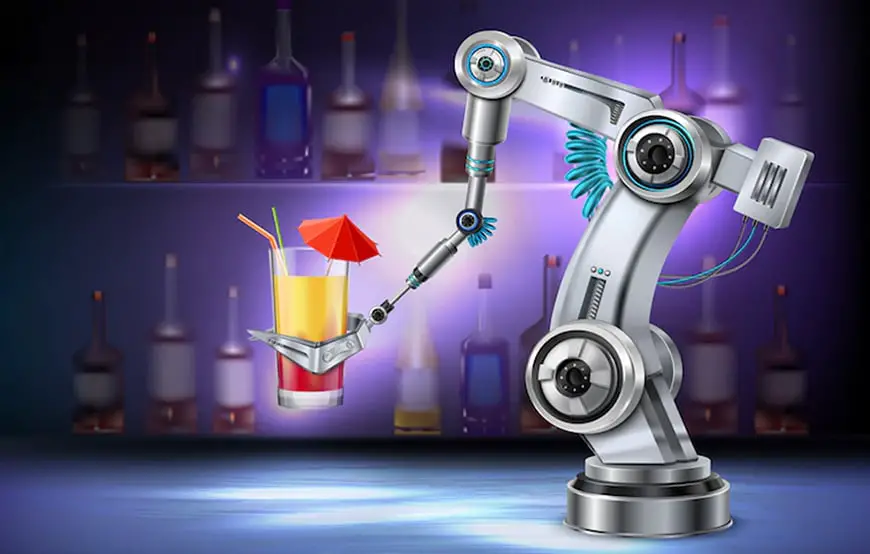Introduction: Food Robotics
Many food and beverage firms are beginning to realize the benefits of utilizing robots to increase production. They are being employed in diverse roles ranging from cocktail preparation to burger flipping. The revolution in automation has begun.
It’s no surprise that robots for the food and beverage business are becoming more widespread as technology progresses and AI becomes more accessible.
These robots, which are autonomous, intelligent, and contactless, can help restaurants and hotels. They can automate the food or beverage production process, save money and human resources, enhance menus, make fewer mistakes, reduce food waste, and work around the clock without demanding a raise. Customer-facing robots can assist to eliminate human touch, which is a big benefit for COVID-19 riddled world, in addition to being pretty cool and introducing innovation into businesses.
AI enabled smart kitchens
The food robotics industry is thriving. According tore Reports and Data, the food robotics market size is expected to reach USD 4,924.7 Million by 2028, registering a CAGR of 11.5%. and this is apparent in the increasing investment in food robotics across the world.
For instance, Soft Robotics Inc., an award-winning food robotics firm, recently raised a USD 10 million Series B extension to expand commercial operations in response to the COVID-19 epidemic. The funds will also be used to launch the company’s SoftAI-powered robotic products. SoftAI combines 3D vision and artificial intelligence technology with Soft Robotics’ patented and proven IP69K-rated soft gripping to provide industrial robots with human-like hand-eye coordination. For the first time ever, this unparalleled combination of robotic “hands,” “eyes,” and “brains” allows for the automation of bulk picking processes (such as bin picking) in the food supply chain. Material Impact, Scale Venture Partners, and Calibrate Ventures led the investment, which also includes Tyson Ventures, Tyson Foods’ venture capital arm.
Pazzi – The World’s First Autonomous Pizza Robot
That the restaurant industry is therefore beginning to use robots should come as no surprise. Here are 7 of the most cutting-edge inventions and robots for the food and beverage sector
- Chowbotics’ Sally – A Salad-Making Robot
Sally, a salad-making robot recently bought by delivery startup DoorDash, can combine up to 8 fresh ingredients, ranging from vegetables to salmon, into a recyclable bowl in under 90 seconds!
Sally not only helps fast-food chains expand their menu and add salads and healthier options without hiring additional staff or changing anything in their kitchen, but she also helps to add a touch of fun experience to the customers.
2.Cecilia.ai – The Interactive Robot Bartender
Consider how much better your drinks menu would be if you could have premium cocktails prepared automatically by a nice and amusing bartender. Cecilia.ai is a smart, interactive bartender that can be installed practically anywhere, serves mixed cocktails in under 30 seconds, and uses AI and speech recognition to provide menu advice to consumers.
This small-footprint robotic bartending machine could easily be installed and operated as the main or backup bartender in hotels, casinos, and cruise ships.
- Picnic — Pizza-Making Machine
Everyone loves pizza, and the Picnic Pizza System makes it a lot easier to make it. Starting with spreading the sauce, topping it with cheese, adding pepperoni and three additional ingredients, and baking the pizza, the entire process may be automated in this modular and customized system.
Picnic can make hundreds of pizzas every hour with just one operator, freeing up the rest of the staff to work on other tasks. The company just secured USD 16.3 million and intends to deploy its robot in schools, stadiums, and hospitals.
Robot Powered Pizza Chain Of The Future.
- Mini Bakery – Automated Loaf Maker
Wilkinson Baking Company invented and designed the Mini Bakery, which is a completely automated bread baking system. It does all of the mixing, shaping, proofing, and baking, allowing customers to buy hot, fresh bread from a vending machine. Mini Bakery can produce 10 loaves each hour, saving time and money while also contributing water to Africa for every bread sold. This technology could be utilised in restaurants or hotel kitchens, even if it was designed for supermarkets.
Connected Robotics – Robotic kitchen Japan
- Miso Robotics- A Robotic Kitchen For Fast Food Restaurants
The business behind Flippy, one of the most well-known robotic kitchen assistants in the industry, which can flip burgers and produce fries while humans tackle the less dangerous and greasy chores.
The Miso Analytics platform is part of the system, and it gives deep insights and enhances food quality by cooking precisely as specified. CaliBurger and White Castle are two of the company’s clients, and each month it flips 10K burgers and fries more than 12K baskets of fries.
- Kitchen Robotics – Robotic Dark Kitchen
Kitchen Robotics is an Israeli contender in the robotic kitchens category. Beastro, a robot designed for “Dark Kitchens,” was developed by the business. The Dark Kitchen, also known as ghost kitchens or virtual kitchens, is a kitchen dedicated solely to delivery-only restaurants, a trend that has exploded since the global pandemic started in 2020.
Beastro may be adapted to produce any sort of meal mechanically, at a rate of roughly 45 dishes per hour, collect data, and fully integrate with Cuismo, the company’s online restaurant, and dark kitchen management software.
Beastro by Kitchen Robotics
- TrueBird- A Fully Automated Micro-Café
TrueBird wants to offer something fresh to the table, despite the fact that there are many coffee-making robots and “old-school” vending machines. The startup teamed with craft breweries in New York City to provide clients with high-quality coffee at a low price, which is manufactured automatically by a 20-square-foot kiosk that uses three small magnets to pour the cup.
While TrueBird’s primary business plan is to open dozens of self-serve coffee shops in public locations and can also be used in hotel or airport lounge
